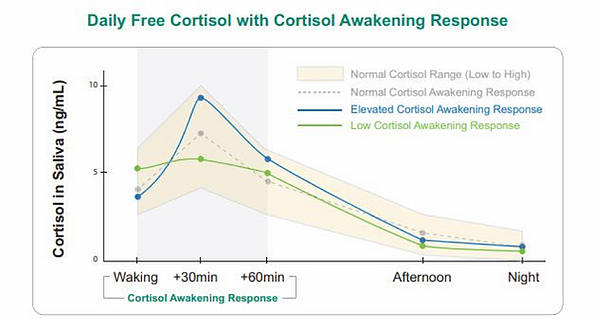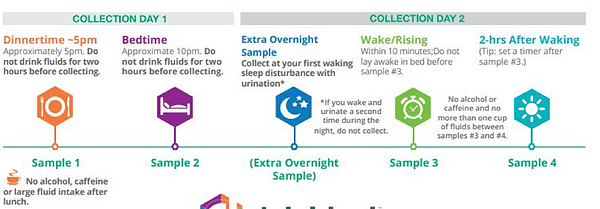🔥 New: 7 Ayurvedic Secrets to Lose Weight & Energize
What is the DUTCH Test?

DUTCH, which stands for Dried Urine Test for Comprehensive Hormones, is the most advanced hormone test, offering an extensive profile of sex and adrenal hormones and melatonin, along with their metabolites, to identify symptoms of hormonal imbalances
What is the Difference Between DUTCH Complete and DUTCH Plus?
The DUTCH Complete test is a comprehensive assessment of sex and adrenal hormones and their metabolites. It also includes the daily, free cortisol pattern, organic acids, melatonin (6-OHMS), and 8-OHdG.
The DUTCH Plus™ takes hormone testing to a whole new level. In addition to sex hormones and their metabolites, the DUTCH Complete looks at the overall diurnal pattern of free cortisol, and the total and distribution of cortisol metabolites.
The DUTCH PlusTM offers an evaluation of the Cortisol Awakening Response (CAR) by measuring salivary cortisol upon waking and then again 30 and 60 minutes later (additional measurements are made around dinner and bedtime). Research has shown that this post-waking increase in cortisol (the CAR) is the best way to assess an individual’s stress response and HPA-axis function.
Why Use DUTCH?
- 1.
The Easiest Patient Collection: Patients collect just four or five dried urine samples over a 24-hour period. Dried samples are stable for several weeks making them convenient to ship worldwide.
- 2.
Analytical and Clinical Validation: Precision Analytical’s testing methods go through a rigorous validation process to verify accuracy, recovery, and linearity. We pride ourselves in relentlessly pursuing the most accurate and precise techniques available for testing. See the data on the next page to support the analytical and clinical validation of this powerful new testing model.
- 3.
Effective HRT Monitoring: DUTCH testing was designed to be optimally effective for most forms of hormone replacement therapy. Unique methods are used for improved monitoring of oral progesterone and vaginal hormones
How does DUTCH compare to other hormone tests?
The key differences between IgE allergies and IgG sensitivities are summarized below:
DUTCH vs. Saliva Testing
While the free cortisol pattern in saliva has clinical value, there is a significant missing piece to surveying a patient’s HPA-Axis function with saliva testing – measuring cortisol metabolites. To properly characterize a patient’s cortisol status, free and metabolized cortisol should be measured to avoid misleading results when cortisol clearance is abnormally high or low. Likewise with sex hormones, measuring estrogen and androgen metabolites gives a fuller picture for more precise clinical diagnosis of hormonal imbalances and HRT monitoring.
DUTCH vs. Serum Testing
While the most universally accepted testing method (due to the availability of FDAcleared analyzers that are reliable and inexpensive), serum testing is lacking in some areas. Adrenal hormones cannot be effectively tested in serum because free cortisol cannot be tested throughout the day. There is also a lack of extensive metabolite testing (especially for cortisol and estrogens).
DUTCH vs. 24-Hour Urine Testing
There are two primary drawbacks to 24-hour urine testing of hormones. First, the collection is cumbersome, and as many as 40% of those who collect, do so in error (Tanaka, 2002). Secondly, dysfunction in the diurnal pattern of cortisol cannot be ascertained from a 24-hour collection. Some providers add saliva for daily free cortisol. DUTCH eliminates the need for two tests.
When should testing for DUTCH be considered?
It is best suited for issues around hormone and cortisol imbalance, including:
Menopause difficulties
premenstrual symptoms (PMS)
Sleep disorders
depression & anxiety
mood swings
High stress levels
HPA axis disorder and Adrenal fatigue
weight gain
fatigue
low libido
PCOS
hair loss
sleeping troubles and insomnia
Alzheimer’s dementia
Low immune system
Markers in the DUTCH
What markers are being tested in the DUTCH Complete?
Progesterone Metabolites
• b-Pregnanediol
• a-Pregnanediol
Androgen Metabolites
• DHEA-S
• Androsterone
• Etiocholanolone
• Testosterone
• 5a-DHT
• 5a-Androstanediol
• 5b-Androstanediol
• Epi-Testosterone
• 5α-Reductase Activity
Estrogen Metabolites
• Estrone (E1)
• Estradiol (E2)
• Estriol (E3)
• 2-Hydroxyestrone (2-OH-E1)
• 4-Hydroxyestrone (4-OH-E1)
• 16-Hydroxyestrone (16-OH-E1)
• 2-Methoxyestrone (2-Methoxy-E1)
• 2-Methoxyestradiol (2-Methoxy-E2)
• 2-Hydroxyestradiol (2-OH-E2)
• 4-Hydroxyestradiol (4-OH-E2)
• Methylation-activity
• 24 hour cortisol
• 11b-HSD index (coltisol/cortisone balance)
Cortisol and Cortisone
• Diurnal Pattern of Free Cortisol (waking, morning, afternoon, night)
• Diurnal Pattern of Free Cortisone Cortisol (waking, morning, afternoon, night)
• 24 hr free cortisol
• 24 hr free cortisone
• a-Tetrahydrocortisol (a-THF)
• b-Tetrahydrocortisol (b-THF)
• b-Tetrahydrocortisone (b-THE)
• Metabolized Cortisol (THF+THE)
Organic Acids
• HVA (Homovanillic acid)
• VMA (Vanillylmandelic acid)
• KYNA (Kynurenic acid)
• MMA (Methylmalonic acid)
• Xanthurenate
• Pyroglutamate
• 8-OHdG (8-Hydroxy-2-deoxyguanosine)
• Melatonin (6-OH-Melatonin-Sulfate)
What markers are being tested in the DUTCH Plus?
Progesterone Metabolites
• b-Pregnanediol
• a-Pregnanediol
Androgen Metabolites
• DHEA-S
• Androsterone
• Etiocholanolone
• Testosterone
• 5a-DHT
• 5a-Androstanediol
• 5b-Androstanediol
• Epi-Testosterone
• 5α-Reductase Activity
Estrogen Metabolites
• Estrone (E1)
• Estradiol (E2)
• Estriol (E3)
• 2-Hydroxyestrone (2-OH-E1)
• 4-Hydroxyestrone (4-OH-E1)
• 16-Hydroxyestrone (16-OH-E1)
• 2-Methoxyestrone (2-Methoxy-E1)
• 2-Methoxyestradiol (2-Methoxy-E2)
• 2-Hydroxyestradiol (2-OH-E2)
• 4-Hydroxyestradiol (4-OH-E2)
• Methylation-activity
• 24 hour cortisol
• 11b-HSD index (coltisol/cortisone balance)
Cortisol and Cortisone
• Diurnal Pattern of Free Cortisol (waking, w+30, w+60, afternoon, night) (saliva)
• Diurnal Pattern of Free Cortisone Cortisol (waking, w+30, w+60, afternoon, night) (saliva)
• Saliva Cortisol Total (saliva)
• Saliva Cortisone Total (saliva)
• a-Tetrahydrocortisol (a-THF) (urine)
• b-Tetrahydrocortisol (b-THF) (urine)
• b-Tetrahydrocortisone (b-THE) (urine)
• Metabolized Cortisol (THF+THE) (urine)
• Creatinine (waking, morning, afternoon, night) (urine)
Add-on markers
• * Saliva Cortisol - Insomnia Above range 2.1 ng/mL 0 - 0.9
• * Saliva Cortisone - Insomnia
Organic Acids
• HVA (Homovanillic acid)
• VMA (Vanillylmandelic acid)
• KYNA (Kynurenic acid)
• MMA (Methylmalonic acid)
• Xanthurenate
• Pyroglutamate
• 8-OHdG (8-Hydroxy-2-deoxyguanosine)
• Melatonin (6-OH-Melatonin-Sulfate)

Price
| Test | Price* | |
DUTCH Complete: |
$475* | Get Your Complete Kit |
| Get Your Complete Kit | ||
DUTCH Plus: |
$575* | Get Your Plus Kit |
| Get Your Plus Kit |
*Price includes 60-min nutrition interpretation consultation
What can the DUTCH Plus™tell us that the DUTCH Complete™ and other adrenal tests cannot?
Even though a patient may have “normal” free cortisol levels throughout the day, that doesn’t always mean everything is functioning properly. The graph below shows two good examples. A blunted or exaggerated Cortisol Awakening Response (CAR) can appear, even when single samples return “normal” results. The HPA axis might not be appropriately responding when faced with a stressor, even when cortisol levels are fluctuating nicely throughout the day. The “stress” of waking allows us to test the HPA axis in a way that has been independently correlated to clinical outcomes and cannot be assessed by other cortisol tests on the market

Sample Report
Collection Instructions
What days of the month do I collect?
Cycling Premenopausal Women Begin collection between days 19 and 22 of a 28-day cycle.
For longer cycles, add the number of days you usually go beyond 28 days. In a similar manner, subtract if your cycles are shorter (example: collect days 17-20 for a 26 day cycle).
You may collect any day if only ordering the DUTCH Adrenal or DUTCH OATs.
For irregular cycles or non-cycling (ablation or uterus removed), watch the irregular cycle collection video in the video library at dutchtest.com/videos for suggestions on collecting.
Men & Non-Cycling or Postmenopausal Women Collect any day.
How to Collect?
Type: urine collection
Complete all information on each collection device.
Saturate the filter paper by urinating directly on it OR use a clean cup and dip the filter paper.
Leave the collection device open to dry for at least 24 hours.
Once dry, close each collection device. Place all devices in the resealable plastic bag and return in the provided envelope. Be sure to include the completed requisition form (required) and the payment card (if needed)
When to Collect?
While adhering to your most common wake/sleep schedule, collect as close as possible to the below timeline. No Alcohol, Caffeine or Large Fluid Intake after lunch before collecting the dinner sample. No more than one cup of fluids between Samples #3 and #4.
Watch Your Water/Fluid Consumption Do not drink any fluids for two hours before collecting each sample. We suggest you keep fluids to < 32oz on day 1, and < 8oz between waking (sample 3) and 2-hrs after waking (sample 4).

Using Hormones?
DO NOT TAKE oral DHEA 48 hours before, or any oral estrogen* or pregnenolone 72 hours before your first collection. *Do not skip doses of birth contol for this test unless instructed by your practitioner.
Any other hormones taken at NIGHT (including oral progesterone) should be taken after the bedtime sample. Generally, hormone creams or gels can be taken as usual during the test. All hormones taken in the MORNING should not be taken until after sample #4.
If you take glucocorticoids (Prednisone, Dexamethasone, etc.) check with your practitioner. For patches, pellets and injections, collect midway between doses.
If you take sublingual hormones (absorbed in the mouth or under the tongue) or if you take oral hydrocortisone USING HORMONES? (cortisol), visit dutchtest.com for specific video instructions.
About Precision Analytical
Precision Analytical was started by Mark Newman with the help of some very talented physicians and analytical chemists. It is a CLIA certified laboratory run by a small team of dedicated scientists with combined experience of over 50 years in performing laboratory tests and developing novel testing methods.
FAQs
Do values compare favorably to 24-hour collections?
The DUTCH correlation to 24-hour collections is excellent (see graph, left). Because the dried samples span about 12-14 hours of the day (6-8 hours overnight plus 2 hours per day collection), they represent the entire day’s hormone production. A weighted average of the four samples is combined and measured for all hormones other than cortisol and cortisone. Values must be presented relative to creatinine (ng per mg of creatinine) to correct for hydration. This replaces the 24-hour value. The excellent correlation to 24-hour collections makes this model a very respectable alternative to 24-hour collections. With the addition of diurnal free cortisol, it becomes an improvement.
Do dried samples compromise the analysis?
Dried samples are accurate for hormone testing, and values correlate to liquid samples. Samples are stable once they are dried and easier to ship than liquid samples.
Methods Used for Testing?Cortisol, cortisone, 8-OHdG, melatonin (6-OHMS), organic acid tests and metabolites related to cortisol are tested by LC-MS/MS. The remaining hormones are tested by GC-MS/MS. The most accurate methods available are used for all tests. These methods show increased accuracy over immunoassays used in typical serum and saliva testing.
What if I miss a collection?
Simply collect the sample as instructed the following day. All samples do not need to be collected in one 24-hour period.
Do I have to take the samples in the order listed?
No, they can be collected in a different order. If you wish you may start with sample #3, followed by #4, #1 & #2. If you begin with #3, collect the extra sample if you wake and urinate in the night.
How long can I keep the dried samples before sending them in?
While hormone levels are very stable in dried samples, they should be sent back as soon as possible. If you have to wait to send them in, place in freezer (in plastic bag) after drying.
Do I need to stop taking my hormones for this test?
This test is built to test patients “on” their hormones. Our suggestion is to follow the Hormone Schedule (listed previously), and any specific instructions given by your provider.
What if my sleep schedule is abnormal (night workers, etc.)?
Collect the bedtime sample (#2) before your longest stretch of sleep, the waking sample (#3) after this sleeping period, and sample #4 two hours later. The dinnertime sample (#1) should be collected 4-7 hours before bed.
What if I am unable to urinate at the specific time?
Simply drink some fluids and go as soon as you are able.
Is DUTCH testing appropriate for children?
The minimum age for testing is 12 years old. To test children under 12, we strongly recommend the DUTCH Cortisol Awakening Response (CAR) measured with saliva.

Questions? Contact us
412 Elden Street, Herndon, VA 20170

